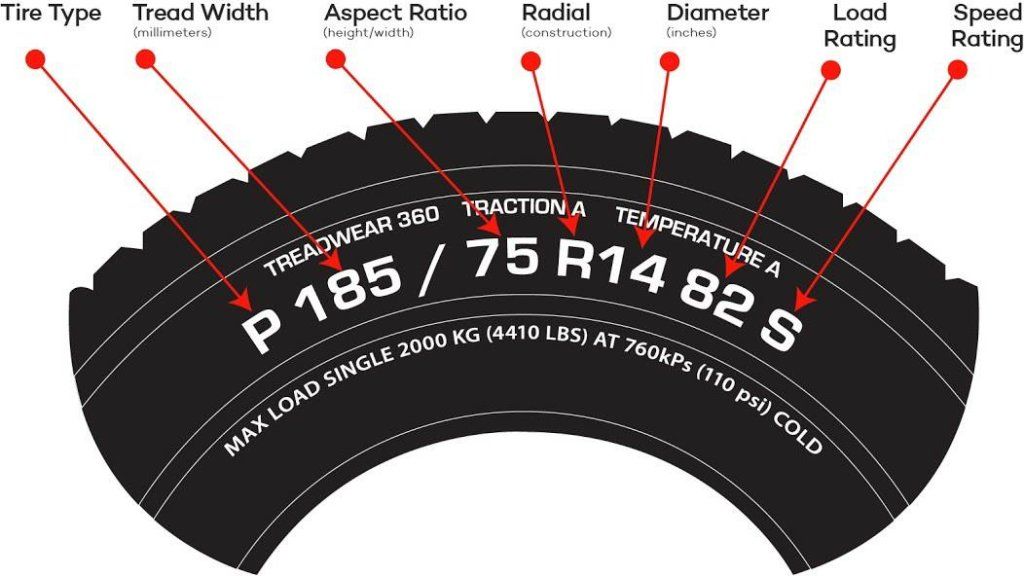Tires June 14, 2021
Being able to quickly glance at the sidewall of your tire and determine the tire size your specific vehicle needs can save you time, trouble and money. Even still, not many people know how to actually read a tire size even though it’s printed right there on the sidewall. As a mix of letters and numbers, it’s not as easy to read as finding a size 9 shoe.
Why Tire Size MattersOther than the fact that tires need to physically fit on your vehicle, there are several reasons why having the correct tire size is necessary.
Your tires support the entire weight of your vehicle and are the only parts of your car that actually make contact with the road. Making sure that you select the proper tire size when it’s time to shop for new tires is critical to the health of your tires and vehicle.
A tire’s job is to carry your vehicle and guide it where it needs to go, so when a tire is too large or too small, not only is performance hindered but your safety is also put at risk. Your tires need to be wide, strong and thick enough to carry the weight of your vehicle while still being able to turn and move. Scratching along the sides or getting caught while trying to turn could cause serious damage to your tires, forcing you to replace them much sooner than you’d otherwise need.
Looking at tire size for the first time can feel like reading a foreign language, but once you learn how to break down what each section of the tire size means, you’ll find they’re not all that complicated.
Tire TypeTire type refers to the service or type of vehicle that the tire was designed for. “P” stands for “passenger” and is the most common type of tire. “LT” (light trucks that carry heavy loads) is another common tire type designation that you’ll likely run into. Other tire types include “T” (temporary), “ST” (trailer) and “C” (commercial). If there is no letter, that usually indicates that the tire was manufactured in Europe for European cars.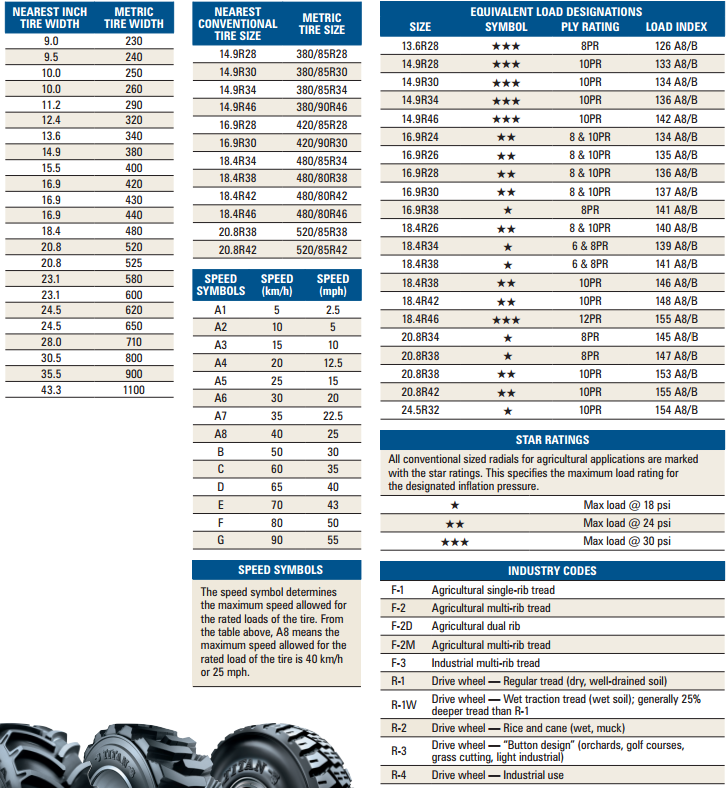 These types of tires are called metric or Euro-metric tires and are similar in many ways to a passenger tire.
These types of tires are called metric or Euro-metric tires and are similar in many ways to a passenger tire.
Measured in millimeters, this is the distance from sidewall to sidewall across the width of your tire.
Aspect Ratio/ProfileAspect ratio refers to the relationship between the tire’s sidewall height and the tire’s width in the form of a percentage. Sidewall height can be determined by measuring the distance between the edge of the rim and the top of the tire at the edge of the tread. Aspect ratio translates to how well your vehicle can handle the tire. The higher the aspect ratio, the longer it takes for your tire to respond to a turning command, making lower aspect tires often easier to command.
Construction TypeThis refers to how the tire was constructed. Typically, you’ll only see “R” for “radial tire” since that is the most common type of tire produced nowadays. Radial tires are constructed by assembling piles perpendicular to the direction that they travel, allowing for a smoother ride, longer tread life and reduced fuel production.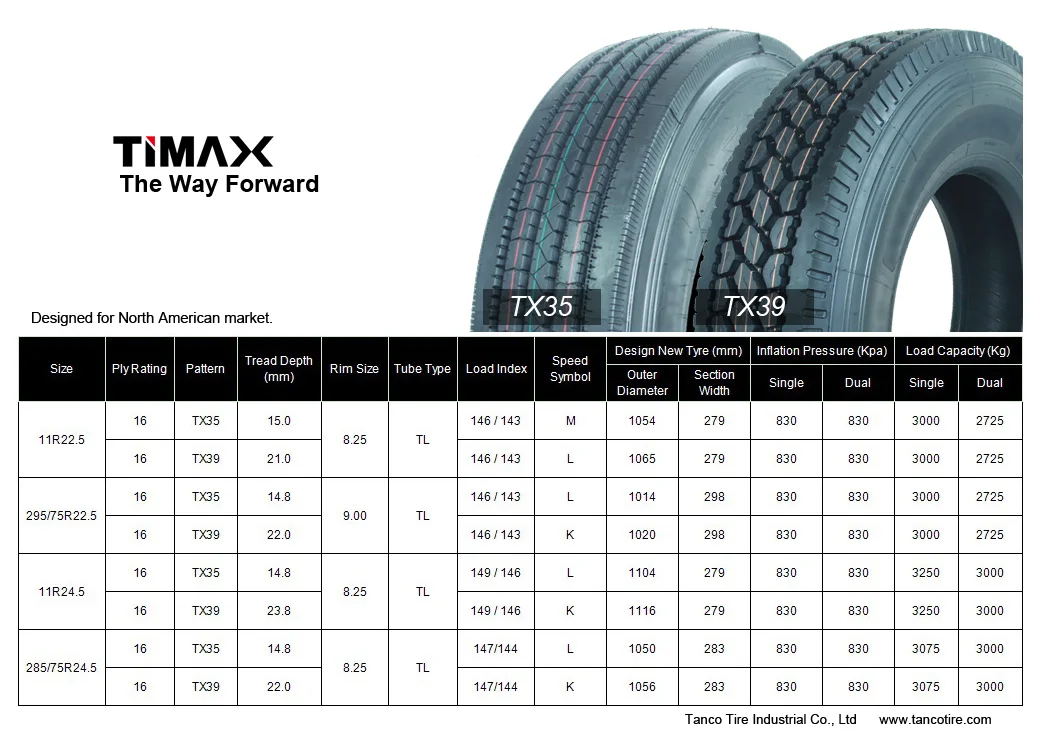
Measured across the center of the tire from one end to the other, wheel size refers to the diameter of your wheel and is typically measured in inches. Overall wheel size is often indicated by the rim diameter as a shorthand for what size tire your vehicle needs.
Load IndexLoad index is a shorthand way of describing the total weight that the tire can handle when it is fully inflated. The higher the load index rating, the more weight the tire can carry. You need a tire load index rating chart to see how your load index rating correlates to the weight the tire can carry. For example, a load index of 81 means that the tire can carry up to 1,019 pounds. Load index ratings for the average vehicle range from 75-100, but some tires can range all the way up to 150, which equates to 7,385 pounds.
Speed RatingLike load index, speed rating is another shorthand way to reference how fast the tire is designed to go.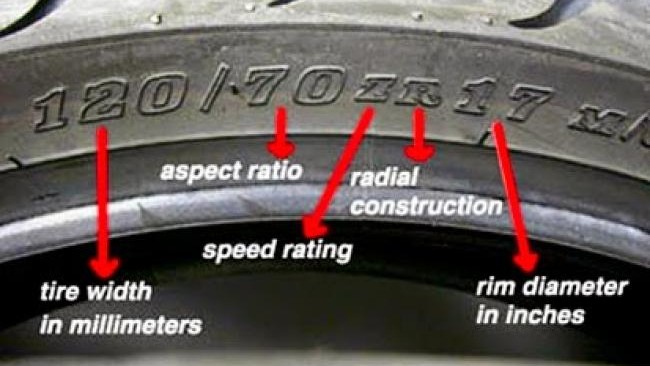 It is indicated by a letter that corresponds to the maximum speed of the tire. For example, a speed rating of “T” means that the tire is designed to go up to 118 miles per hour.
It is indicated by a letter that corresponds to the maximum speed of the tire. For example, a speed rating of “T” means that the tire is designed to go up to 118 miles per hour.
Read: A Guide to Tire Load Index & Speed Ratings
How to Read Tire SizesBreaking down a tire size measurement into its individual parts makes it easy to read once you’re in the know. Now that you know what each element of tire size means, we can walk through an example of how to read a tire size off of a sidewall.
Example: P255/45R18 103HP (Tire Type): This tire is a passenger tire, one of the most common types of tires.
255 (Tire Width): The tire width is 255 millimeters from sidewall to sidewall (just over ten inches).
45 (Aspect Ratio): The tire’s sidewall is 45% of the tire’s width, which means the sidewall is about 114 millimeters or just over 4 inches.
R (Construction Type): Radial tire, the most common type of tire produced today.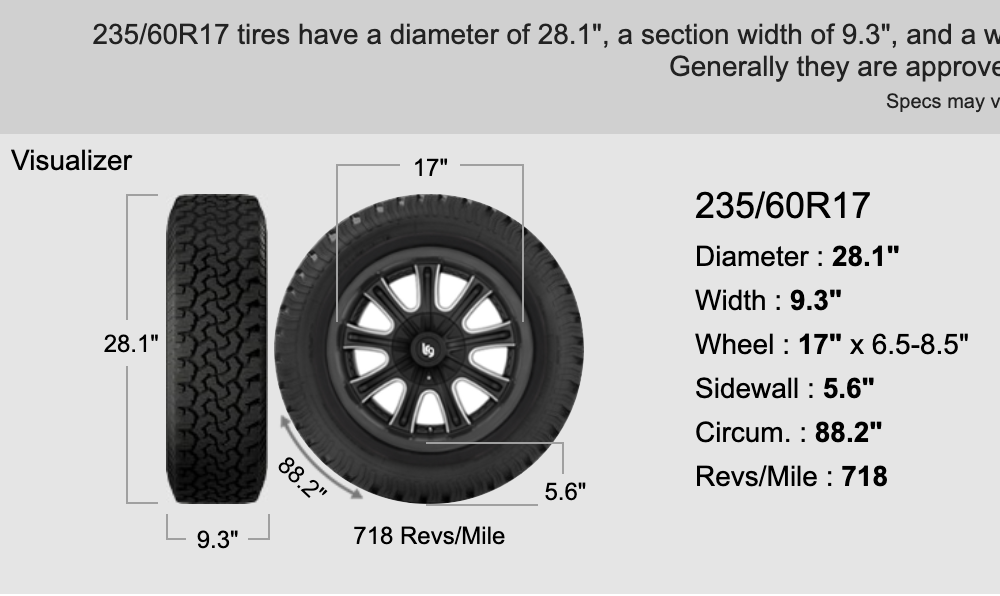
18 (Wheel Size/Rim Diameter): Going from edge to edge, the tire’s diameter is 18 inches across.
103 (Load Index): A load index of 103 means this tire can carry up to 1,929 lbs.
H (Speed Rating): A speed rating of “H” means that this tire is designed to withstand speeds up to 130 miles per hour.
In summary, a P255/45R18 103H tire would be a passenger tire with a width of 255 millimeters, a thickness or aspect ratio equal to 45% of the tire height which here is 114 millimeters. It is also a radially constructed tire with a diameter of 18 inches that can carry up to 1,929 pounds and can go up to 130 mph.
We’ll Help You Decode All Your Tire NeedsIf reading tire sizes still seems like a mystery, drop by your local Virginia Tire & Auto and let our tire experts walk you through the process. We’ll help you find the exact tire your vehicle needs. Schedule a visit online or call 855.425.3677 to talk to a tire expert.
Reference
Knowing your Jeep's tire size can be essential information when it comes time to replace that rubber, or even if you ever decide to change wheels. And while a stock tire size is imprinted right inside the driver side B pillar, you may not know what if have if you are not the original owner.
And while a stock tire size is imprinted right inside the driver side B pillar, you may not know what if have if you are not the original owner.
So here is some helpful information to assist you in determining what you currently have on the vehicle.
First, the sidewall of your tire contains all the information needed to understand everything about that specific tire. All tires are required to have this information, regardless of the manufacturer brand name.
Now, this information could read in a few different ways. For example, it could simply say 35x12.5 R17, or it may show as P265 75 R15. If it is the first listing, then here is the breakdown. That first number is your tire size at 35", and then the second number tells you the tire width at 12.5". That third reading is the tire type as radial and diameter as 17".
The second listing is a metric set up, and is what is more common on factory-type sized tires. From left to right, the P indicates a passenger tire while 265 indicates the tires width in millimeters..jpg) That 75 is the tire's aspect ratio and simply means the tire's height is equal to 75 percent of its width. Finally, like the first set of numbers, that R15 means it is a radial tire and has a 15" diameter.
That 75 is the tire's aspect ratio and simply means the tire's height is equal to 75 percent of its width. Finally, like the first set of numbers, that R15 means it is a radial tire and has a 15" diameter.
For those who have the metric reading on their tires, you can simply plug that into the conversion calculator to determine the tire size, or find that corresponding reading on one of the below conversion charts.
Enter the metric size (i.e. 285/75 R17)
| Metric | Standard |
|---|---|
| 215/75/15 | 27.7"x 8.5" |
| 225/70/15 | 27.4"x 8.9" |
| 225/75/15 | 28.3"x 8.9" |
| 235/75/15 | 29.0"x 9.3" |
| 245/75/15 | 29.5"x 9.6" |
| 255/75/15 | 30.0"x 10.0" |
| 265/75/15 | 30.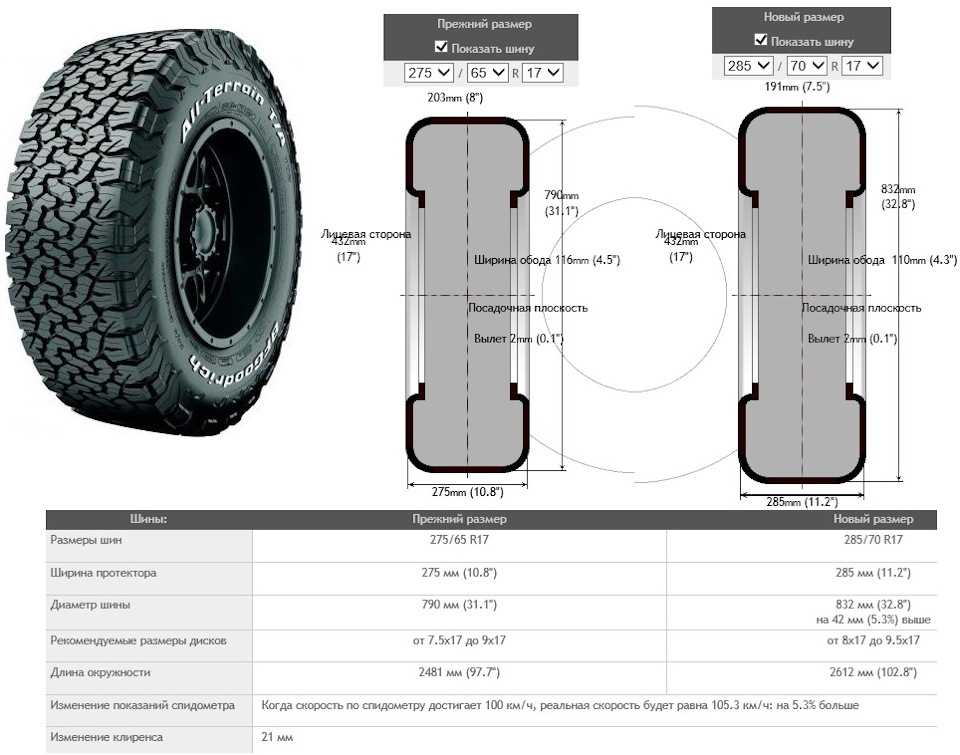 6"x 10.4" 6"x 10.4" |
| Metric | Standard |
|---|---|
| 205/85/16 | 29.7"x 8.1" |
| 215/75/16 | 28.7"x 8.5" |
| 225/70/16 | 28.4"x 8.9" |
| 225/75/16 | 29.2"x 8.9" |
| 235/70/16 | 29.0"x 9.3" |
| 235/85/16 | 31.7"x 9.3" |
| 245/70/16 | 29.5"x 9.6" |
| 245/75/16 | 30.5"x 9.6" |
| 255/70/16 | 30.0"x 10.0" |
| 265/70/16 | 30.6"x 10.4" |
| 265/75/16 | 31.6"x 10.4" |
| 275/70/16 | 31.2"x 10.8" |
| 285/75/16 | 32.8"x 11.2" |
| 295/75/16 | 33.4"x 11.6" |
| 305/70/16 | 33.0"x 12.2" |
| 315/75/16 | 34.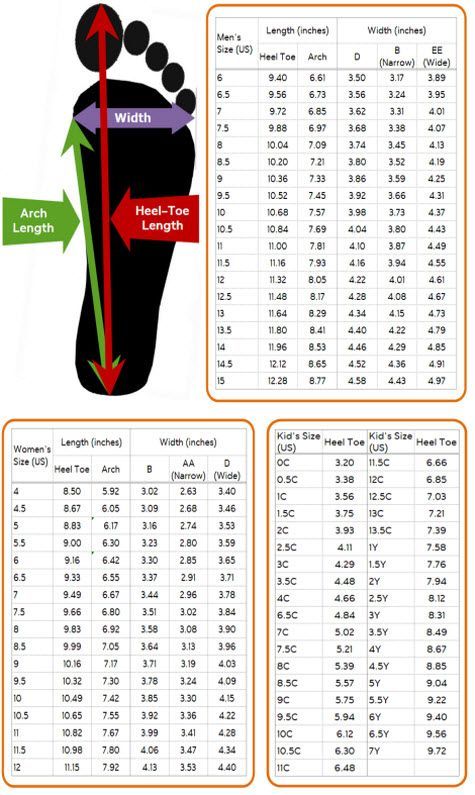 8"x 12.4" 8"x 12.4" |
| 375/55/16 | 32.8"x 15.5" |
| 395/70/16 | 37.9"x 16.0" |
| Metric | Standard |
|---|---|
| 245/70/17 | 30.6"x 9.8 |
| 265/70/17 | 31.6"x 10.7 |
| 285/70/17 | 33.0"x 11.5 |
| 315/70/17 | 34.4"x 12.4 |
| Metric | Standard |
|---|---|
| 275/65/18 | 32.1"x 11.0 |
| 375/50/18 | 33.0"x 15.4 |
| 325/60/18 | 33.2"x 13.3 |
| 325/65/18 | 34.8"x 13.5 |
| 305/70/18 | 35.0"x 12.2 |
| 375/60/18 | 35. 7"x 15.5 7"x 15.5 |
| 395/65/18 | 37.8"x 15.7 |
| Metric | Standard |
|---|---|
| 325/50/20 | 33.0"x 13.2" |
Metric measurement example: 225/70R15
225 = Section width in millimeters
70 = Aspect ratio (ratio of section height to section width)
R15 = Rim diameter
R = Radial Construction, B = Bias Construction, D = Bias Belted Construction
Calculations for Measurements
Tire Width: Section width divided by 25.4 (Ex: 225 / 25.4 = 8.86")
Section Height: Tire width times aspect ratio (Ex: 8.86" x 70% = 6.20")
Overall Diameter: Section height times 2 plus rim diameter (Ex: (6.20" x 2) + 15 = 27.40")
See all tires here
When Is It Time To Change My Jeep's Tires?
Choosing The Best Jeep Tires
How Do You Rotate Jeep Tires?
Tags:
How To Prepare For Off-Roading in Moab
Like anything else, if you really want the most out of a trip to Moab, you need to do the prep work.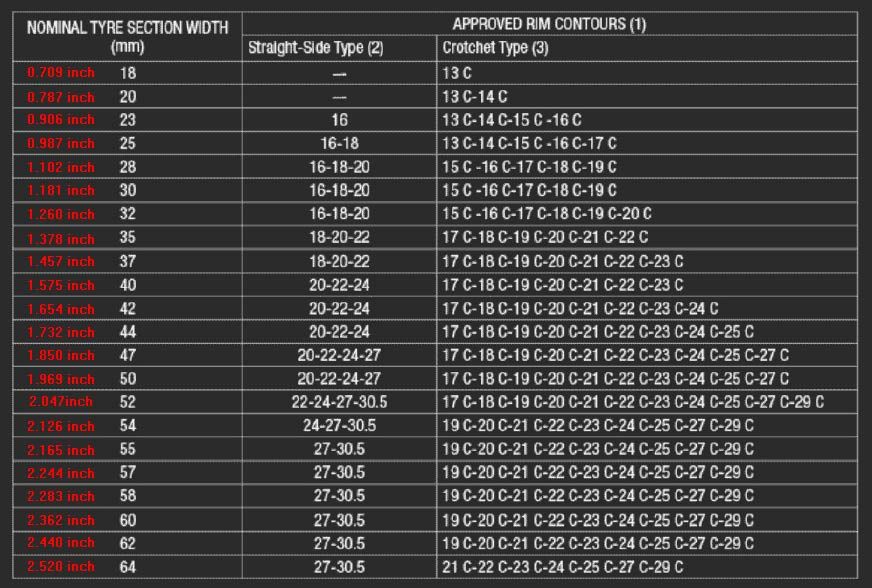
READ MORE
March Maintenance: Brakes
As one of the most crucial systems on your Jeep, brakes and components should definitely be on your vehicle inspection schedule.
READ MORE
Alpine i509-WRA-JL 9" Multimedia Dash Restyle System Jeep Wrangler JL & Gladiator JT
Moab, EJS Offer History And Much, Much More
Even though the place is on the smaller side, it carries a huge amount of history and fun.
READ MORE
Third Jeep Concept Crop Promises Plenty Of Electrified Power For 2023 Easter Jeep Safari
A nod to the new and old from this latest Jeep concept image release.
READ MORE
Oracle Lighting LED Off Road Side Mirror Lights for Jeep Wrangler JL & Gladiator JT
What Is The Best Jeep Wrangler Engine?
With more powerplant options than ever, is there really one that stands out against the crowd?
READ MORE
Jeep To Dealers: Expect 2024 Wrangler Changes
While not a full-on overhaul, this refresh does add some interesting items and options.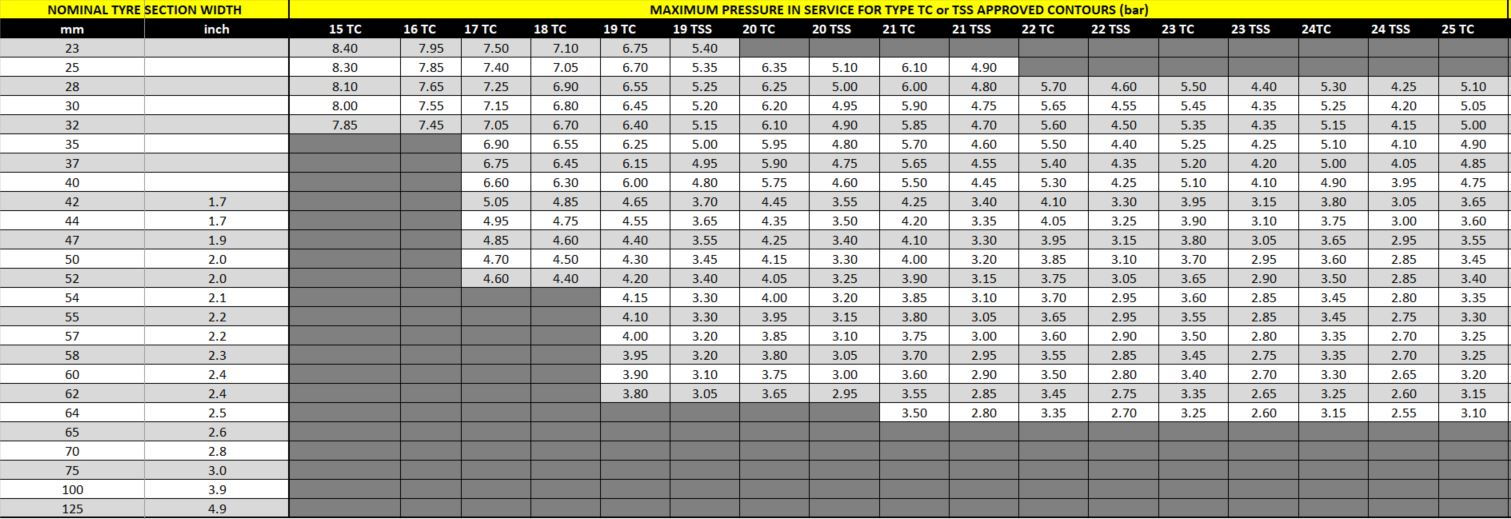
READ MORE
Diode Dynamics Hitch Mount LED Pod Reverse Light Kit Install & Review
home
Articles
* These tables are for informational purposes only and are not intended as a guide to action. For specific applicability of non-standard discs, please contact the vehicle manufacturer or vehicle dealer. We do not test wheel interchangeability and cannot make recommendations.
| Landing width of the disc | Minimum tire width | Optimum tire width | Maximum tire width |
|---|---|---|---|
| 5.0 inches | 155 mm | 165 or 175 mm | 185 mm |
| 5.5 inches | 165 mm | 175 or 185 mm | 195 mm |
6.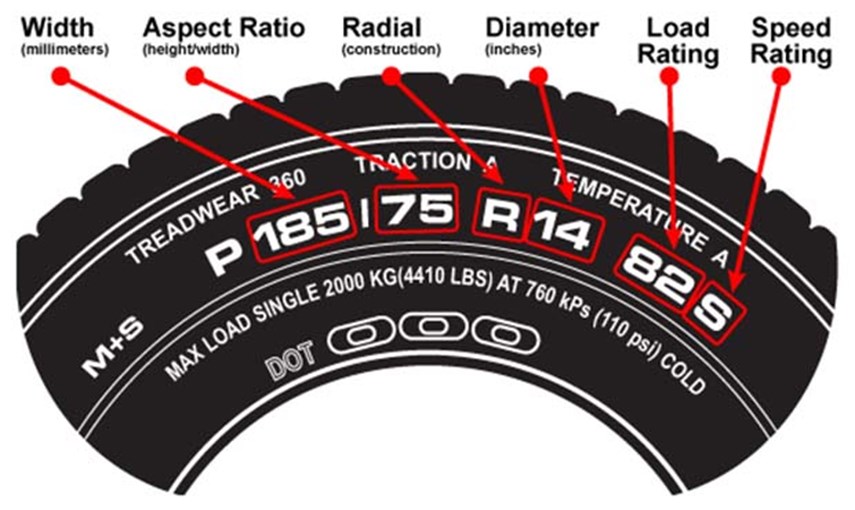 0 inches 0 inches | 175 mm | 185 or 195 mm | 205 mm |
| 6.5 inches | 185 mm | 195 or 205 mm | 215 mm |
| 7.0 inches | 195 mm | 205 or 215 mm | 225 mm |
| 7.5 inches | 205 mm | 215 or 225 mm | 235 mm |
| 8.0 inches | 215 mm | 225 or 235 mm | 245 mm |
| 8.5 inches | 225 mm | 235 or 245 mm | 255 mm |
| 9.0 inches | 235 mm | 245 or 255 mm | 265 mm |
| 9.5 inches | 245 mm | 255 or 265 mm | 275 mm |
| 10.0 inches | 255 mm | 265 or 275 mm | 285 mm |
| 10.5 inches | 265 mm | 275 or 285 mm | 295 mm |
11. 0 inches 0 inches | 275 mm | 285 or 295 mm | 305 mm |
| 11.5 inches | 285 mm | 295 or 305 mm | 315 mm |
| 12.0 inches | 295 mm | 305 or 315 mm | 325 mm |
| 12.5 inches | 305 mm | 315 or 325 mm | 335 mm |
| Profile | Designation in metric dimension | Permissible range of landing width of the disk |
|---|---|---|
| 35 Series | 275/35R17 | 9.0-10.5 |
| 335/35R17 | 11.0-13.0 | |
| 345/35R15 | 11.0-13.5 | |
| 40 Series | 285/40R15 | 11.0-13.5 |
| 215/40R15 | 7.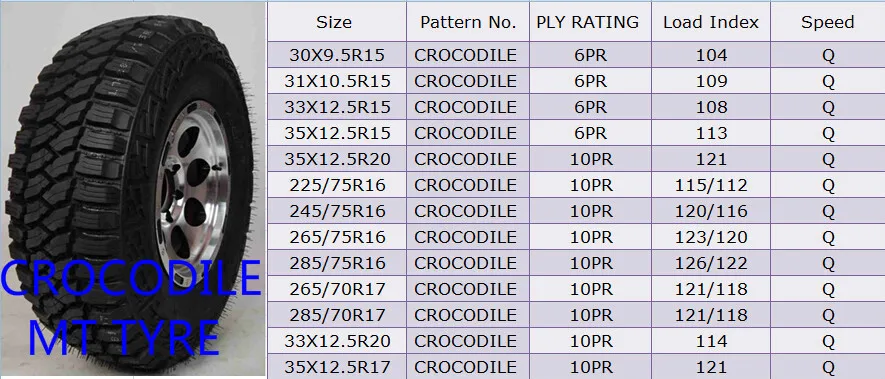 0-8.5 0-8.5 | |
| 245/40R17 | 8.0-9.5 | |
| 255/40R17 | 8.5-10.0 | |
| 265/40R17 | 8.5-10.0 | |
| 235/40R18 | 8.0-9.5 | |
| 45 Series | 195/45/R15 | 6.5-7.5 |
| 215/45R15 | 7.0-8.5 | |
| 255/45R15 | 8.5-10.0 | |
| 205/45R16 | 7.0 | |
| 225/45R16 | 7.5-9.0 | |
| 245/45R16 | 8.0-9.5 | |
| 215/45R17 | 7.0-8.5 | |
| 235/45R17 | 8.0-9.5 | |
| 255/45R17 | 8.5-10.5 | |
| 50 Series | 175/50R13 | 5.0-6.0 |
| 195/50R14 | 5.5-7.0 | |
| 205/50R15 | 5. 5-7.5 5-7.5 | |
| 215/50R15 | 6.0-7.5 | |
| 225/50R15 | 6.0-8.0 | |
| 195/50R16 | 5.5-7.0 | |
| 205/50R16 | 5.5-7.5 | |
| 225/50R16 | 6.0-8.0 | |
| 235/50R16 | 6.5-8.5 | |
| 215/50R17 | 6.5-7.5 | |
| 55 Series | 205/55R14 | 5.5-7.5 |
| 185/55R15 | 6.0-6.5 | |
| 195/55R15 | 5.5-7.0 | |
| 205/55R15 | 5.5-7.5 | |
| 205/55R16 | 5.5-7.5 | |
| 225/55R16 | 6.0-8.0 | |
| 60 Series | 185/60R13 | 5.0-6.5 |
| 205/60R13 | 5.5-7.5 | |
| 185/60R14 | 5.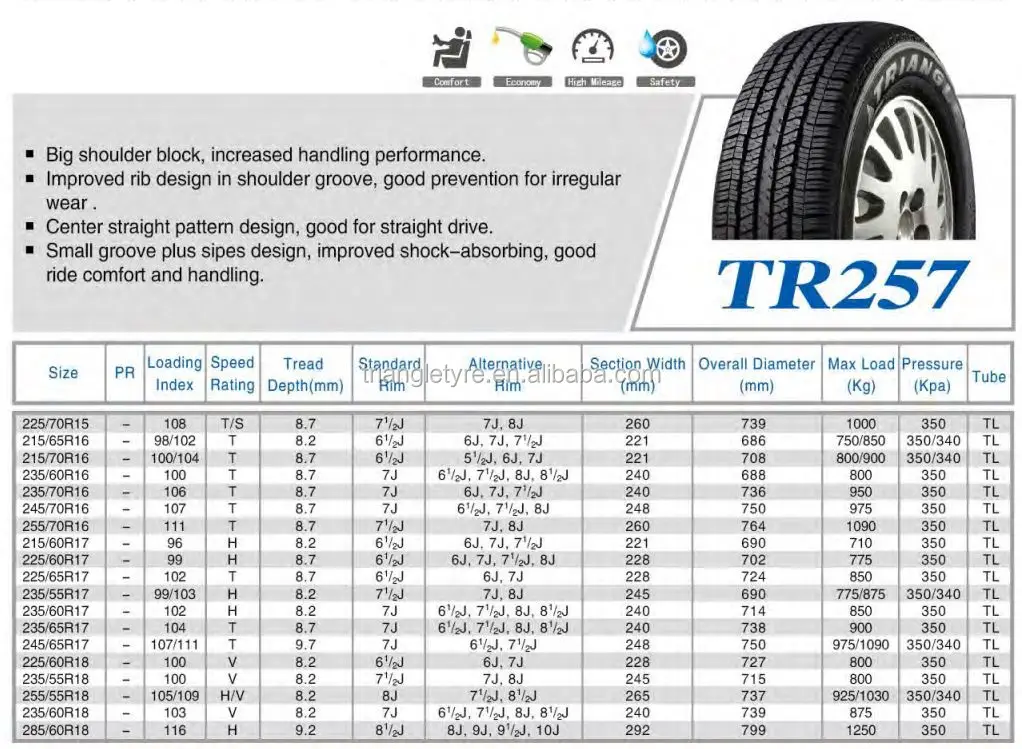 0-6.5 0-6.5 | |
| 195/60R14 | 5.5-7.0 | |
| 205/60R14 | 5.5-7.5 | |
| 195/60R15 | 5.5-7.0 | |
| 205/60R15 | 5.5-7.5 | |
| 215/60R15 | 6.0-7.5 | |
| 225/60R15 | 6.0-8.0 | |
| 235/60R15 | 6.5-8.5 | |
| 65 Series | 185/65R15 | 5.0-6.5 |
| 195/65R15 | 5.5-7.0 | |
| 205/65R15 | 5.5-7.5 | |
| 215/65R15 | 6.0-7.5 | |
| 70 Series | 165/70R10 | 4.5-5.5 |
| 175/70R12 | 5.0-6.0 | |
| 175/70R13 | 5.0-6.0 | |
| 205/45R16 | 7.0 | |
| 185/70R13 | 5.0-6.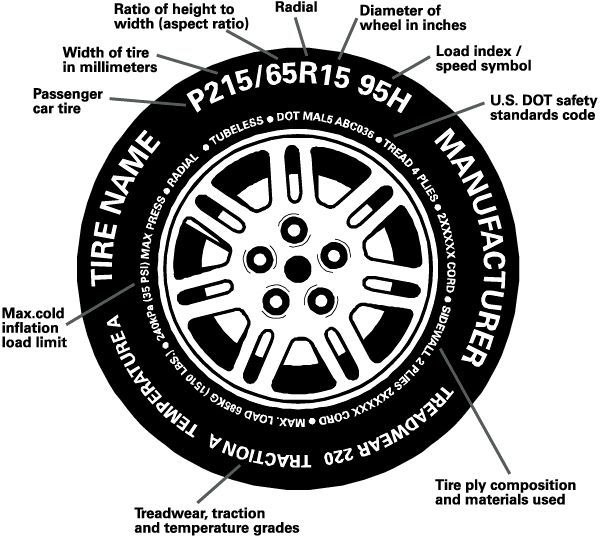 5 5 | |
| 185/70R14 | 5.0-6.5 | |
| 195/70R15 | 5.5-7.0 | |
| 205/70R14 | 5.5-7.5 | |
| 185/70R15 | 5.0-6.5 | |
| 205/70R15 | 5.5-7.5 | |
| 215/70R15 | 6.0-7.5 | |
| 82 Series | 155R12 | 4.0-5.0 |
| 155R13 | 4.0-5.5 | |
| 165R13 | 4.0-5.5 | |
| 175R14 | 4.5-6.0 | |
| 185R14 | 4.5-6.0 | |
| 165R15 | 4.0-5.5 | |
| Profile | Designation in metric dimension | Permissible range of landing width of the disk |
|---|---|---|
| 75 Series | P205/75R15 | 5..jpg) 5-7.5 5-7.5 |
| P215/75R15 | 5.5-7.5 | |
| P225/75R15 | 6.0-8.0 | |
| P235/75R15 | 6.0-8.0 | |
| 80 Series | P155/80R13 | 4.5-5.5 |
| P165/80R13 | 4.5-6.0 | |
| P175/80R13 | 4.5-6.0 | |
| P185/80R13 | 5.0-6.5 | |
| 35 Series | P315/35R17 | 10.0-12.0 |
| 40 Series | P275/40R17 | 8.5-10.0 |
| 50 Series | P215/50R13 | 5.5-8.5 |
| P235/50R13 | 6.0-9.0 | |
| P245/50R14 | 6.5-9.0 | |
| P225/50R15 | 6.0-8.0 | |
| P295/50R15 | 7.5-11.0 | |
| P225/50R16 | 6.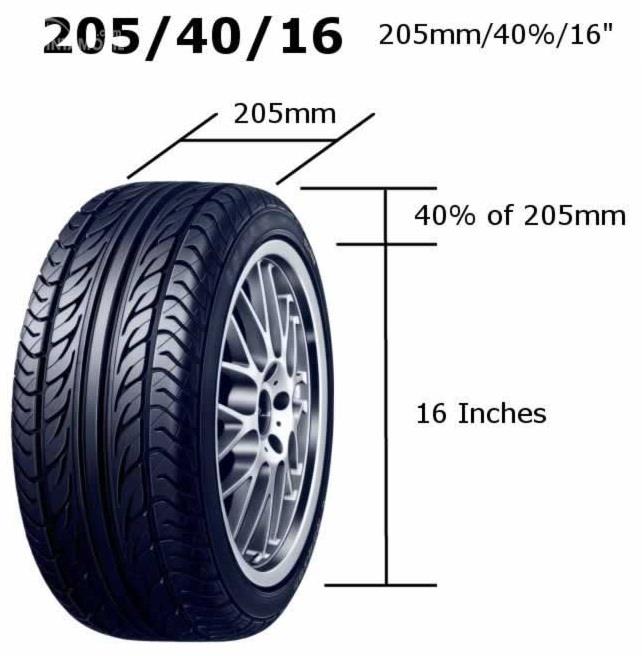 0-8.0 0-8.0 | |
| P245/50R16 | 6.5-9.5 | |
Return to list
American and European tires are distinguished by their markings. European tires have a metric marking system. Therefore, when replacing tires, the problem of translating tire parameters may arise. In most cases, this is the conversion of inches to centimeters. Enter the size in inches and click calculate. You will see the tire size in meters (dimensions will be rounded to European parameters).
|
Comparison: inch and meter sizes When you enter the old inch parameters and new European ones, you can see how the external parameters of the tire and ground clearance will change, as well as differences in the speedometer readings. |
|
| ||||||||||||||||||||||||||||||
Thanks to the Tire Calculator, you can do the reverse calculation - convert "cm" and "mm" to inches.